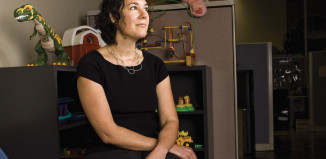A lot has changed since the inception of Ballet Austin more than 50 years ago when dancers with the then Austin Ballet Society first performed excerpts from “The Nutcracker” at the now defunct City Coliseum. Their performance – as impressive as it may have been – was some- what overshadowed by the malodorous livestock show that succeeded it.
Today, it’s not the same old song and dance at Ballet Austin. Thankfully, dancers no longer must share the stage with farm animals. In fact, the nonprofit organization’s new downtown digs – a former printing press building renovated into a series modern, spacious studios, administrative offices and a flexible theater space – are finally worthy of the talent and accomplishment ensconced within.
Ballet Austin made the move from Guadalupe Street and its longtime “firehouse” location (so called because of its history as a maintenance garage for the Austin Fire Department) to its new home at 501 W. Third St. a year ago, and the change has breathed new life in to the business.
The Ballet Austin Academy, the official ballet school of the organization, has grown in to one of the largest in the country. By upgrading from two dance studios at the firehouse to seven at the new location, dancers with Ballet Austin II – the apprenticeship program and second company – as well as those with the principal company, now have more available space for rehearsals. Adding an in-house theater and opening the Butler Community School – which offers various open-to-the-public dance, athletics, yoga and pilates classes – also enhanced Ballet Austin’s community outreach.
“Being in this new location has been great,” says Stephen Mills, artistic director at Ballet Austin. “No matter what we have going on at the ballet, you can come to a show, then go have a beer and hit the clubs afterwards. That was part of our goal of being downtown. It’s a very lively area to be part of.”
For Mills, a world-renowned choreographer, working in Austin has its benefits and drawbacks.
“When it comes to Texas, people think culture stops in Houston,” he conveys. “So sometimes it can be tough getting people to take our company seriously.”
However, some truly awe-inspiring and transcendent performances, married with Mills’ award-winning choreography and commitment to dancer mentoring, have gained the com- pany some well-deserved accolades. After Mills’ inaugural season as artistic director in 2000, Dance Magazine called his production of “Hamlet” “sleek and sophisticated.” Several years later, after the company performed Mills’ rendition of “The Taming of the Shrew,” The Washington Post referred to Ballet Austin as “one of the nation’s best-kept secrets.” Not too shabby for an artistic director who didn’t start dancing until the age of 18.
Mills has worked tirelessly to develop unique productions in a range of styles that move and educate audiences, as is most apparent in his works “Cult of Color: Call to Color” and “Light: The Holocaust and Humanity Project.”
“The goal for the company is to be able to bring audiences a wide array of dance experiences,” Mills says. “There are so many things for people to experience here. And I really think of my role of artistic director as being one of a curator and an educator.”
In his progression from dancer to resident choreographer to artistic director at Ballet Austin, Mills has also had to learn more about the business of the art, and the community support needed to keep a nonprofit afloat.
“It’s important to know why people invest in your organization and you have to develop those relationships in order to receive that support,” Mills says. “Art does not exist in America without that kind of community support.”
He hopes to see that support come from more diversified outlets in coming years. And speaking of diversity, Mills’ aspirations for Ballet Austin include a more diverse audience.
“I think that the most valid way to diversify your audience is by allowing people to see themselves represented on stage, either through the dancers or a work that represents them in an authentic way,” he says.
As Ballet Austin prepares for the five productions company dancers will perform in its 2008-2009 season, Mills says he’s looking forward to some more changes. Six new dancers are joining the company, a shift that provides him an opportunity to develop and hone young talent. And Ballet Austin’s return to The Kennedy Center in Washington, D.C., for a collaborative performance in “The Suzanne Farrell Ballet” is an adventure worthy of some excitement.
“That trip,” says Mills, “will be a fantastic opportunity to represent Austin and show the rest of the dance world what we can do.”




































